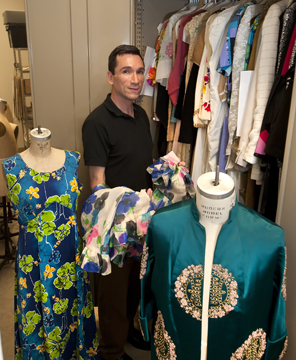Did You Know?: Theatre's Special Collection of Historic Dress

Joel Ebarb, associate professor of theatre and costume design, stands among a portion of the Department of Theatre Special Collection of Historic Dress, which he also curates. (Purdue University photo/ Mark Simons)
What began as a few delicate pieces of clothing set aside in a closet is now an educational archive documenting the history of Western fashion. The Department of Theatre Special Collection of Historic Dress, which was created in 1997, features clothing, shoes and accessories dating from the 1850s to the present.
Through donations from members of campus and the community, along with thrift store and eBay purchases, Joel Ebarb, associate professor of theatre and costume design and curator of the collection, has accumulated more than 1,120 items.
From a 1900s Edwardian child's dress with 17 types of lace to colorful 1960s caftans, each piece hangs in chronological order or is stored in an acid-free box in a special section of the Pao Hall costume shop. Although pieces in the collection are fragile, all are readily available as teaching tools. Ebarb encourages students, faculty, staff and visitors to go hands-on and examine garment structure, stitching, color and composition.
"You can only get so much from a photo," Ebarb says. "The pieces in the collection are too old, too important, too great an example to be used onstage. The collection is a repository of fashion to be used for study. It is a tangible encyclopedia and a resource for whoever wants to use it."
Men's tuxedos, suits and military uniforms are stored alongside the women's wear that makes up the majority of the collection. The following are some of the most unusual pieces preserved in the collection:
* Oldest -- 1853 evening bodice
* Most expensive -- 1980s Chanel handbag
* Rarest -- 1920s colobus monkey fur coat and matching muff
* Fan favorite -- 1960s Emilio Pucci silk jersey dress
* Purdue connection -- Scottish kilt set donated by the family of the late Leslie Geddes, who was the Showalter Distinguished Professor Emeritus of Biomedical Engineering.
"The collection tells the story of Lafayette," Ebarb says. "There are few haute couture pieces because those are not commonly found in wardrobes around here. The clothes we have start in the 1800s when Lafayette began. This collection is a reflection of Lafayette, West Lafayette and the people who have lived here."
The collection boasts mostly Western styles; however, following trips abroad, community members have donated international pieces including a traditional male garment set from India, a costume from Bali and a few items from Korea and Hong Kong.
To introduce the collection to a broader audience, Ebarb curates exhibits in the Pao Hall art galleries. Ebarb, Dammon Dean Scholars students in the College of Liberal Arts, and students in the Social History of Dress: Why We Wear What We Wear course conduct research and compile historical accounts on each garment to accompany the display pieces.
The next exhibit will be on display Dec. 5-16 in the Patti and Rusty Rueff Galleries in Pao Hall.
